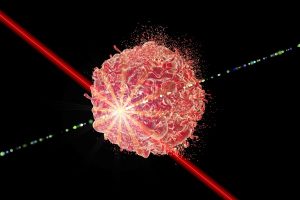Biomedical engineers at Duke University have discovered a way to detect signs of cancer on a cell-by-cell basis using a technique that involves two lasers and a camera. The technique, using biomedical lasers and cameras, can assess an individual cell’s stiffness using patterns that appear within its internal structure.
Several medical devices currently in use and in clinical trials around the world look for increases in cellular stiffness as an indicator of cancerous tissue. These devices, however, rely on readings from many cells clustered together within the body and cannot operate on a cellular level.
Adam Wax, professor of biomedical engineering at Duke University, had previously shown that a cell’s internal structure shifts as fluids flow around its exterior. He also showed that it is possible to calculate cellular stiffness by measuring the amount of that shift. This discovery has many advantages over traditional methods of measuring the rigidity of a single cell. This technique, using two lasers and a camera, allows for zero physical contact with the cell, and measurements took much less time.
Medical technology and equipment is ever-changing. Keeping up with those changes can be a daunting task. Employing UKA to design and develop your precision lenses for your biomedical lasers and cameras will keep your company on the cutting edge of biomedical technology. We take pride in the fact that from beginning to end, all of our work is done in-house. 
“Traditional approaches like atomic force microscopy take all day just to prepare a single sample,” explains Will Eldridge, a PhD student in Wax’s lab and first author of the paper. “Using a moving liquid to measure shear flow only takes 30-40 minutes to image a group of cells.”
In an effort to yield results more quickly, Wax and Eldridge tried to find a visual metric that could do the same job in less time. In a more recent paper, they show that the amount of disorder found within a cell’s internal structure directly correlates to its stiffness. To measure cellular disorder, the researchers shine a laser through a cell and compare it to a second, unobstructed beam. The differences in the amount of time it takes for the two lasers to travel through the sample are then analyzed to produce a clearer picture of the internal structure of the cell.
“The speed of this technique is only limited by the size of your camera’s field of view,” said Eldridge. “You could potentially measure hundreds of individual cells in a matter of seconds.”
“It’s widely known that cellular stiffness is an indicator of cancer, but there’s no viable diagnostic tool that can use that knowledge on a cellular scale,” Wax says. “With this technique, I can see a path to creating a high-throughput system that could quickly and easily screen for cervical, esophageal, or colon cancer—anywhere you could take a tissue scraping.”
More research is still needed to understand the direct correlation between images, but the researchers are hopeful that the technique could be translated into a new biomedical device for cancer screening.
Universe Kogaku designs and manufactures optical lenses for biomedical devices, security, high tech and electronic. We stock 1000’s of standard lens assemblies and can custom design a solution for scanners, CCTV, CCD/CMOS, medical imaging, surveillance systems, machine vision and night vision systems.